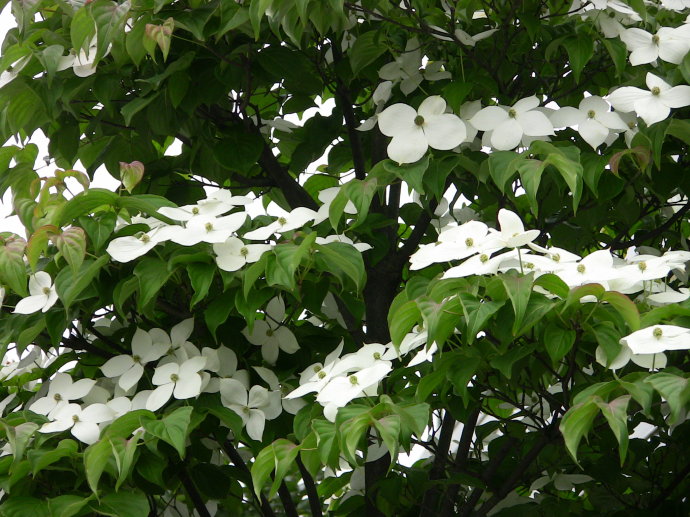Cornus kousa seed
The Kousa Dogwood (Cornus kousa or Benthamidia kousa) is a small deciduoustree 8–12 m tall, native to eastern Asia. Like most dogwoods, it has opposite, simple leaves, which are 4–10 cm long. The tree is extremely showy when in bloom, but what appear to be four petaled white flowers are actually bractsspread open below the cluster of inconspicuous yellow-green flowers. The blossoms appear in late spring, weeks after the tree leafs out. The Kousa Dogwood is sometimes also called chinese Dogwood,Korean Dogwood, or Japanese Dogwood.
The fruit is a globose pink to red compound berry 2–3 cm diameter, though these berries tend to grow larger towards the end of the season and some berry clusters that do not fall from the tree surpass 4 cm. It is edible, a sweet and delicious addition to the tree’s ornamental value.
The fruit is sometimes used for making wine.
Chinese Kousa Dogwood, Cornus kousa chinensis, Tree Seeds
Hardy, Adaptable, Easy to Grow, Showy Flowers, Showy Fall Colors, Exfoliating Bark, Ornamental Fruits, Edible Fruits, Attracts Birds/Butterflies, Wildlife Food/Shelter, Bonsai, Cold and Drought Tolerant
Chinese Kousa Dogwood is a small, deciduous, flowering tree or large multi-stemmed shrub which typically grows 15-30′ tall with a vase-shaped
habit in the early years, maturing to a rounded habit. As in the case of flowering dogwood (Cornus florida), the showy parts of the Chinese dogwood “Flower” (3-5″ across) are the four white, petal-like, pointed bracts which surround the center cluster of insignificant, yellowish-
green, true flowers. The flowers are hermaphroditic with both male and female organs. Bloom occurs in late spring (several weeks after flowering dogwood). Flowers are followed by berry-like fruits to 1″ inch diameter, which mature to a pinkish red in summer and persist into fall. Fruits are edible, but are usually left for the birds. Dark green foliage turns a striking reddish purple to scarlet in autumn. Var. chinensis is almost identical in appearance to the species except that its showy bracts are slightly larger than those of the species.
Chinese Kousa Dogwood is a beautiful but carefree flowering tree that provides visual interest year-round. Even in winter, the eye-catching bark and form of the Kousa bring a unique beauty to your landscape. The distinctive vase shape makes this tree ideal for border and foundation
planting, though it can stand alone as a showpiece tree with ease. The Kousa attracts wildlife of all sorts, and provides a safe haven for birds in the winter time. Its small frame makes it ideal for tight areas, especially for under power lines. The shallow root system of the Kousa makes it especially drought tolerant. You can also plant near homes without fear of the roots damaging any structures. Cold hardy, and resistant to a multitude of pests and disease.
Other Names: Chinese Kousa Dogwood, Japanese Flowering Dogwood, Bethamia japonica
Zone: 5 to 8
Growth rate: Moderate
Plant Type: Small deciduous flowering tree
Family: Cornaceae
Native Range: Japan, Korea, china
Height: 15 to 30 feet
Spread: 15 to 30 feet
Shape: Vase-shaped maturing to rounded
Bloom Time: May – June
Bloom Color: White
Flower/Fruit: Showy white bracts to 5 inches across and surround the small flowers in the center. Flowers are followed by berry-like edible fruits to 1″ inch diameter, which mature to a pinkish red.
Sun: Full sun to part shade
Fall Color: Showy reddish purple to scarlet
Drought tolerance: Good
Water: Medium
Maintenance: Medium
Site Requirements /Soil Tolerances: Grow in average, medium moisture, well-drained soil in full sun to part shade. Prefers sandy, acidic, organically rich soils.
Culture: Minimum pruning is best. Remove crossing or wayward branches to maintain a strong framework, in late winter to early spring.
Uses: A stunning flowering tree or large shrub with good fall color. Plant as a specimen or in small groupings on residential property around
homes, near patios or in lawns. Also effective in shrub borders, woodland gardens, bird gardens or naturalized areas. Good Bonsai.

